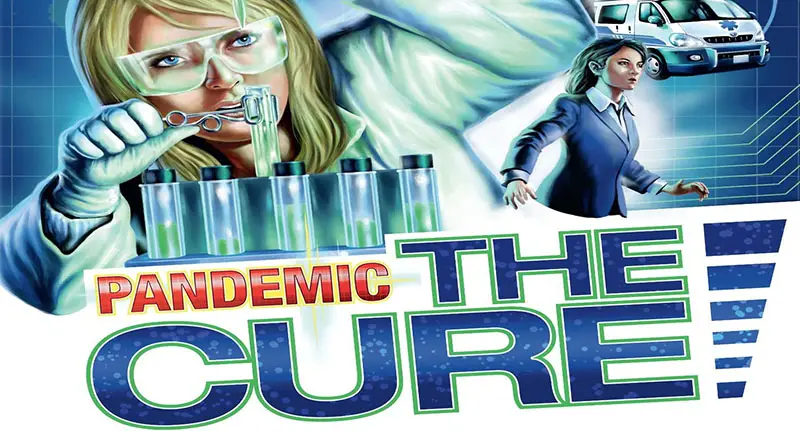
Four deadly diseases threaten to infect the world! Players must work together to prevent disease outbreaks while finding their cures. You'll need more than luck to save the day.
Can you save humanity?
Components
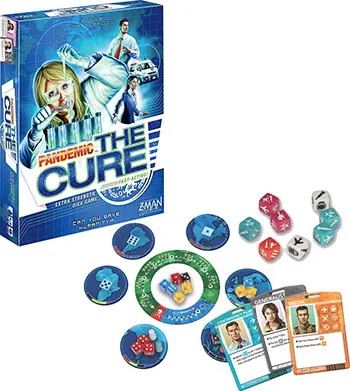
- 48 Infection dice
- 1 Infection bag
- 7 Player pawns
- 7 Role cards
- 37 Player dice
- 6 Region tiles
- 1 Treatment Center
- 1 Outbreaks syringe
- 1 Infection rate syringe
- 1 CDC tile
- 10 Event cards
- 1 Cured Diseases card
- 5 Player aid cards
- Instructions
Setup
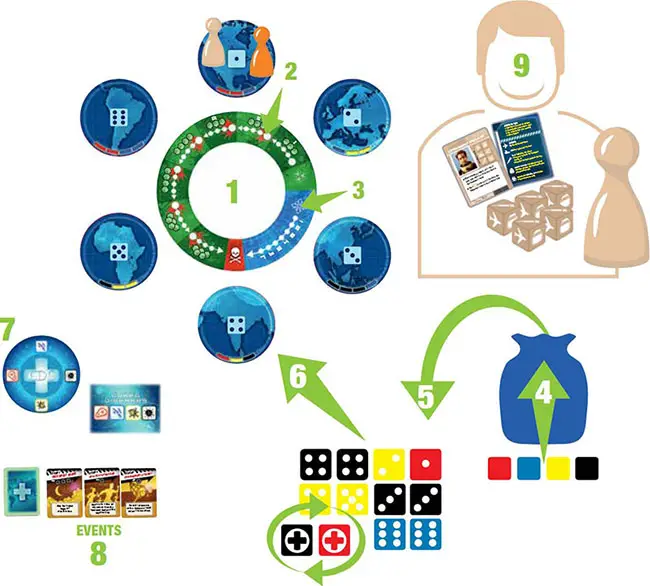
1 Place the Treatment Center in the middle of the table. Place the Region tiles around it as shown (1 to 6, clockwise).
2 Set the infection rate syringe to the STANDARD difficulty (II) setting on the Infection Track (the green track). If this is your first time playing a cooperative game, we recommend the INTRO (I) setting.
3 Set the outbreaks syringe to  (0) on the Outbreaks Track (the blue track).
(0) on the Outbreaks Track (the blue track).
4 Place the 48 Infection dice in the infection bag and mix them.
5. Draw 12 Infection dice from the bag randomly and roll them. Re-roll any cross results until all dice show a number.
6. Place these dice in their matching regions (dice showing a 1 go in region 1, dice showing a 2 go in region 2, etc).. If there are more than 3 dice of one color in any regions, re-roll the extra dice until no regions have more than 3 dice of one color.
7 Place the CDC tile and the Cured Diseases card near the Region tiles, as shown.
8 Mix the Event cards face down and stack them next to the CDC to form a draw pile. Draw the first 3 Event cards and place them face up near the CDC as shown.
9 Shuffle the Role cards and hand one to each player. Hand out the colored pawn and set of player dice matching each role. Put unused Role cards, player pawns, and player dice back in the box. Place the pawns in region 1 (North America).
Object of the Game
Pandemic: The Cure is a cooperative game; all players win or lose together. During play, you'll move around the globe, treating diseases and collecting samples. When you've collected enough samples, you can try to find a cure.
If the players, working together, discover cures for all four diseases, you win! If, however, the Infection rate gets too high, there are too many outbreaks, or the number of infected people grows too large (there aren't enough dice in the bag to draw), then your team loses.
Game Play
Randomly select a player to begin play. Continue play clockwise around the table until the end of the game.
On your turn, you can do four things:
- Roll Player Dice and Do Actions
- Give Samples
- Try to Find a Cure
- Infect Regions
During your turn, other players can give advice, but you decide what to do if players don't agree.
1. Roll Player Dice and Do Actions
Roll all of your player dice. Each die will show either an action or a biohazard symbol. Action results are good. Biohazard results are bad.
Actions
An action result can be spent to do that action or it can be re-rolled. You may re-roll a die showing an action result any number of times, but once it is spent, you cannot re-roll or spend it again this turn. Action dice can be re-rolled or spent in any order, but are spent one at a time.
After Each Action
After spending an action die, set it aside (to remind you not to spend it again this turn).
You do not have to re-roll dice or spend all your actions. (You might skip re-rolling a die to avoid rolling a  biohazard result, see below).
biohazard result, see below).
The four standard actions are:

-

Fly
Move your pawn from your region to any other region.
-

Sail
Move your pawn from your region to a region next to it (as shown).
-
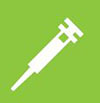
Treat
Put 1 Infection die from your region into the middle of the Treatment Center, or Put 1 Infection die from the Treatment Center into the infection bag.
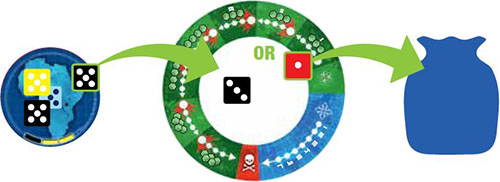
Important: when you treat an Infection die of a disease with a known cure, instead of moving 1 Infection die, move ALL Infection dice of that color from either your region or the Treatment Center.
-
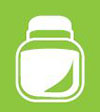
Collect Sample
"Bottle up" a disease sample. Take 1 die of an uncured disease from the Treatment Center and place it, along with your player die showing a "Collect sample" result, onto your Role card as a sample of that disease. (If no dice are in the Treatment Center, you cannot do this action).
A sample (a die with the "Collect sample" result and an Infection die) stays "locked up" on your Role card until you give samples to another player or try to find a cure.
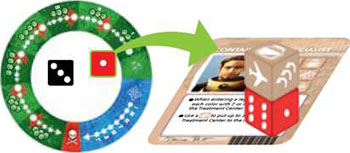

Other Actions
Some roles have dice with more than 1 symbol printed on some die sides, separated by a slash. For these results, you can do one or the other of these actions (not both).
Some roles have special actions on some die sides. The rules for these special actions are on their Role cards. All effects of a die must be completed before moving on to the next die.

Biohazards
Immediately advance the infection rate syringe 1 space for each biohazard result you roll, then set these dice aside (you may play events before advancing the infection rate syringe).
These dice cannot be re-rolled this turn. When the infection rate syringe reaches (or crosses) a  space on the Infection Track, an epidemic occurs.
space on the Infection Track, an epidemic occurs.
Important: if the infection rate syringe reaches the Infection Track end, the game ends and your team has lost!
Epidemics 
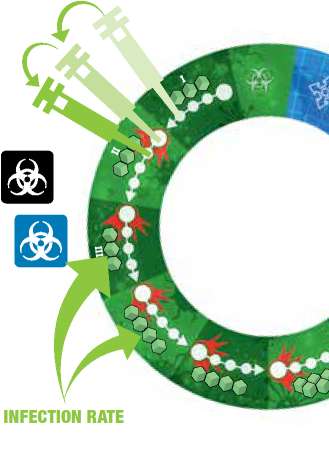
When an epidemic occurs, take into your hand all dice in the Treatment Center plus a number of dice from the bag equal to the new infection rate (the dice shown next to each section of the Infection Track) and roll them.
Put dice with a cross result in the CDC.
Put all dice with number results on the matching numbered regions.
Then, starting with region 1 (North America) and going clockwise, check for outbreaks: if a region has more than 3 dice of one color, an outbreak occurs (see Outbreaks, below).
After an epidemic, the current player may continue with her turn, spending or re-rolling any of her remaining player dice.
Outbreaks 
An outbreak occurs when a region has more than 3 Infection dice of the same color in it. This can happen during an epidemic or when infecting regions.
When an outbreak occurs:
- Advance the outbreaks syringe 1 space.
- Move the extra dice (the dice above 3 in the outbreak color) clockwise to the next region.
Example: North America (region 1) has 3 blue Infection dice and 2 red Infection dice. Colleen rolls 2 blue dice, both showing a "1" as the result of an epidemic.
Since a region can hold only 3 dice of each color, an outbreak occurs. Colleen advances the outbreaks syringe 1 space and moves 2 blue dice from North America (region 1) to Europe (region 2).
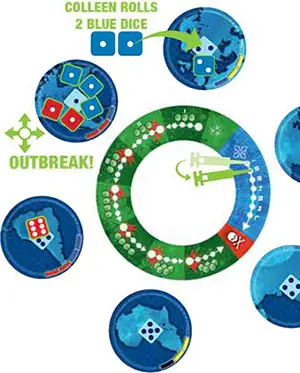
Chain Reactions
If the next region now has more than 3 dice of the outbreak color, it also has an outbreak.
Advance the outbreaks syringe 1 space and move the extra dice above 3 in this color from this region clockwise to the next one.
A region can outbreak more than once per turn.
This can occur if, during the same turn, different colors outbreak or if enough Infection dice of one color are added at two different times.
Important: if the outbreaks syringe reaches 8 outbreaks, the game ends and your team has lost!
2. Give Samples
When you are done rolling and taking actions, if you have any samples on your Role card, you may give samples to another player in your region.
Take all samples of one disease color on your Role card and hand them to one other player in your region. This player puts these samples on her Role card.
Doing this puts more samples of this disease color together, which increases a teammate's chance to find a cure.
3. Try to find a Cure
After rolling and taking actions (and possibly giving samples), you may attempt to find a cure:
Roll all collected samples of one disease color on your Role card. You can try to find a cure only once each turn.
Add the results shown on these dice. Crosses count as 0 (zero). If the total is 13 or more, you found the cure for that color disease! If not, you've failed to find the cure.

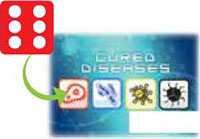
Success
-
Mark this cure by placing one of the Infection dice used to find the cure on the appropriate colored space of the Cured Diseases card.
-
Put the remaining Infection dice (the other samples) you rolled, plus any held as samples by other players, plus any dice of this color in the Treatment Center, in the infection bag.
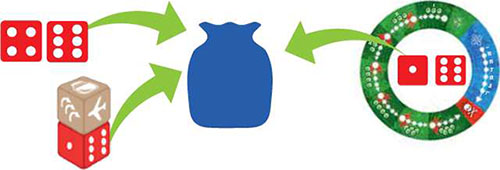
-
Hand the player dice that "bottled up" these samples back to their owners.
Note: after a cure has been found, during infections and epidemics, you still place Infection dice of cured colors into regions! (Although a cure exists, people are still infecting each other).
Having a cure does let your team better treat these diseases.
Note: unlike the board game Pandemic, there is no eradication in Pandemic: The Cure. When you cure a disease and remove all the Infection dice of that color, there is no special effect.
Important: once your team finds cures for all four diseases, your team has won!
Failure
If the total rolled is less than 13, you failed to find a cure. Keep the samples. Next turn, you may give them away as samples or try again to find a cure.
Note: keep any rolled samples with cross results as samples; do not place them on the CDC.
4. Infect Regions
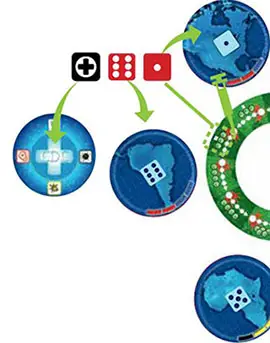
After taking actions - and possibly giving samples and trying to find a cure - draw a number of dice equal to the infection rate from the infection bag (without looking at them) and roll them.
Important: if there aren't enough dice in the bag to draw, too many people have become infected, and your team has lost!
Place all Infection dice showing crosses in the CDC.
Place all Infection dice showing numbers in their matching regions (all dice with "1" results go in region 1, North America, etc)..
Then, starting with region 1 and going clockwise, check each region for outbreaks, resolving any that occur. Then, your turn is over and play passes to the player on your left.
Events
Whenever an Infection die is rolled and a cross result appears, you got lucky and can begin to use helpful events. Place cross dice in the CDC.
To use an event, place the required cross dice into the Infection bag then follow its instructions.
Once you have rolled the dice, you must place them and resolve any outbreaks before any player can play an Event card.
After an event is done, discard its card (face down) to the bottom of the event draw pile and immediately draw a new event and place it face up. (Since you always get a new event after using one, you will always have 3 face-up Event cards in play).
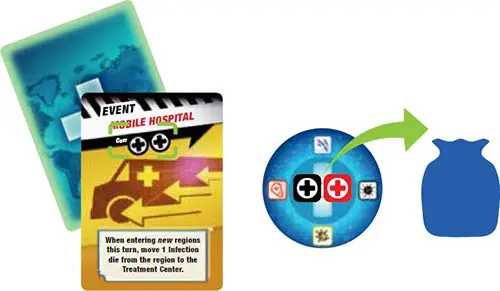
End of the Game
Your team wins as soon as you discover all four disease cures. Congratulations, you saved humanity!
Note: you do not have to treat every Infection die in all regions to win.
Your team can lose (ending the game) in three different ways:
Out of time. If the infection rate syringe reaches the end of the Infection Track.
Too many outbreaks. If 8 or more outbreaks occur.
Too many people infected. If, during an Infect Regions step, there aren't enough dice left in the infection bag to draw and roll. At any time, players may look in the bag so they know how many dice are in it.
Your Next Game
After winning on Intro or Standard difficulty, try Heroic difficulty. Try different roles - the game will play differently. Be flexible - the strategy your team wins with in one game may not work in the next one. Good Luck!
Fine Points
Remove 1 die from a region each time the active player's pawn enters a new region when playing the Mobile Hospital event. The Containment Specialist's power also takes effect when he is moved by the Dispatcher and it takes effect before the Mobile Hospital event takes effect.
When you find a cure for a disease, it doesn't improve the Containment Specialist's special power or the Mobile Hospital event. If you ever begin your turn and all of your dice are locked up as samples, you may unlock one of them to roll. Place the extra Infection die "sample" into the Treatment Center.
The Dispatcher may keep Airlift dice on his Role card for use on other players' turns. Unused Airlift dice can be picked up and rolled along with the other available dice at the beginning of the Dispatcher's turn.
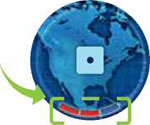
The colored bars on each Region tile give you a clue as to which diseases will appear in each region and with what frequency.
For example, North America gets a lot of red and some blue disease because of the way the Infection dice are designed.
Continue Reading


